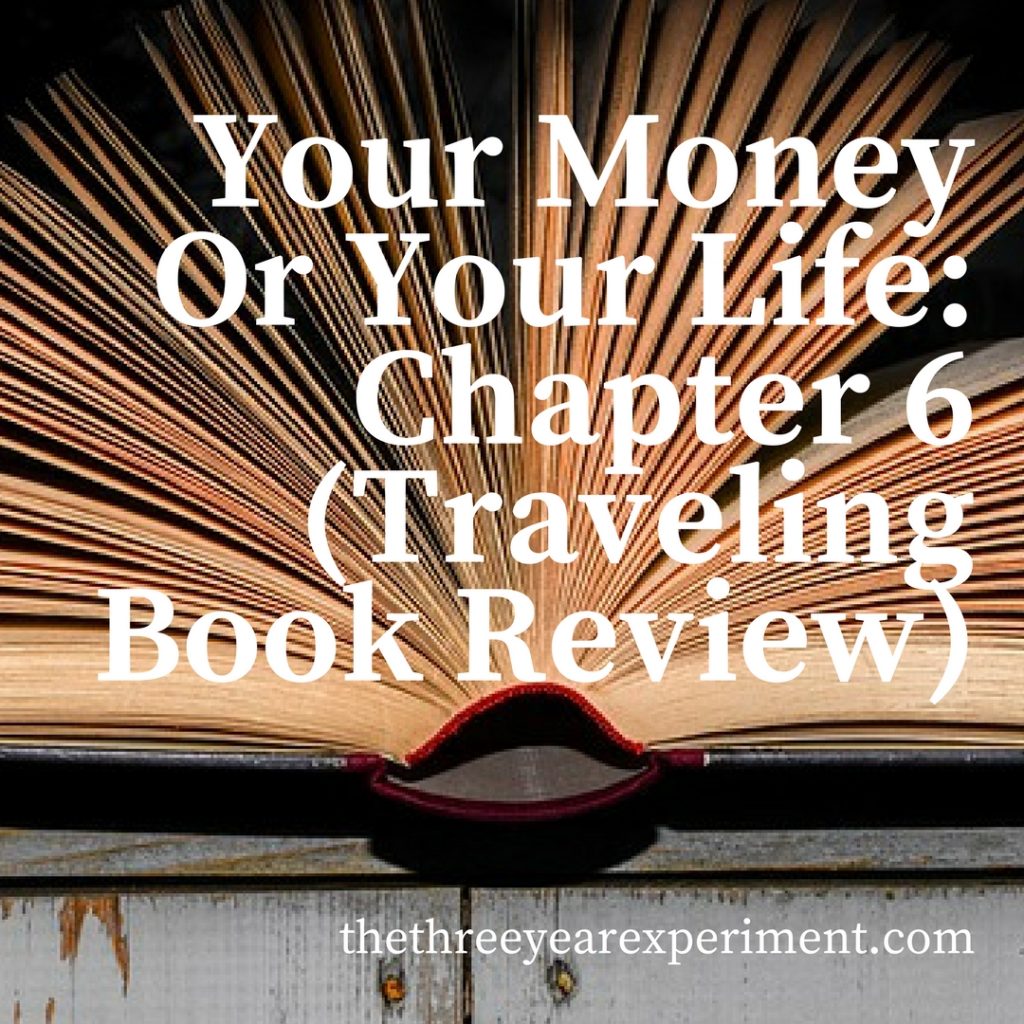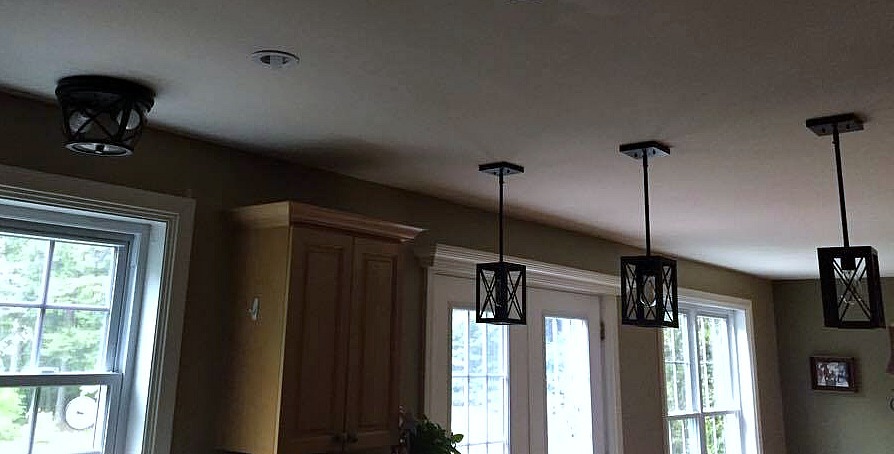Today I’m taking part in a “traveling book review” written by Rockstar Finance bloggers. Each day, a different blogger will review one chapter of one of the best money books I’ve ever read, Your Money or Your Life. Written by Vicki Robin and Joe Dominguez, Vicki’s original coauthor who’s since died, the updated version contains timeless wisdom and current, practical tips for anyone working to make sense of their finances, their work/life balance, and life in general.
If you’d like to read reviews for each chapter, I recommend reading Rockstar Finance’s introduction post with links to reviews of each chapter.
The American Dream–on a Shoestring
Chapter 6 is perhaps the most relevant chapter to my life of the entire book. “Laurie,” it seemed to be saying to me the whole time, “read these words and internalize this message: if you want to achieve true freedom, you must learn to control your spending.”
A few years ago, I would have scoffed at this notion. “As if,” I can hear old me saying,”I’m going to earn more and buy whatever I want.”
This would be a terrific strategy if it worked–if it allowed me to increase my net worth, say, or even my happiness. Then we could get all the stuff we wanted just by working harder, and that would make us happier, and we’d all live happily ever after. All the millionaires and multi-millionaires would never declare bankruptcy or feel sad. Hollywood stars, paid millions per film, would never divorce or go through public scandals.
Unfortunately, life doesn’t work that way. As Robin wisely and gently explains, more stuff doesn’t necessarily bring more happiness. Especially once you’ve got your basic needs met.

What We Really Need
The American Dream really can be had on a shoestring. A shoestring budget, that is. (And is a US shoestring budget really so shoestring? Let’s not forget that 99% of the world’s population live quite happily on less than $33,000 US per year). But the idea of such restraint seems to implicitly strike us as something negative.
“It is both sad and telling that there is no word in the English language for living at the peak of the fulfillment curve, always having plenty but never being burdened with excess,” writes Robin. We need a word that captures the essence of carefully and thoughtfully managing limited resources for optimal happiness. When I think of the word “frugal,” for example, I flash to my Depression-era grandparents who washed out Ziploc bags and saved wrapping paper. Somehow, in our era of excess, the word now evokes miserliness and a life devoid of color, joy, or happiness.
But is it? After all, America was founded on such values. Benjamin Franklin praised “thrift” in Poor Richard’s Almanac: “A penny saved is a penny earned.” New England Puritans built their society on values of hard work, simplicity, and plain living–just enough, no more. “Our bedrock is frugality,” Robin reminds us, “and it’s high time we made friends again with the word–and the practice.”
The Joy of Enough
The authors explain that embracing frugality means embracing the idea of having “enough.” With materialism, a value our society has jumped on in the last several decades, our worth is measured by how much stuff we have. We’ve spent several decades accumulating more and more, in an effort to achieve contentment or, too often, show off our status. Unfortunately, we’re now realizing it’s just not working. There will never be enough. But we’re wizening up, slowly. Books like The Life Changing Magic of Tidying Up by Marie Kondo and movements like minimalism are testaments to our society’s dissatisfaction with buying and acquiring material goods.
In contrast, frugal people “have a high joy-to-stuff ratio. If you get one unit of joy for each material possession, that’s frugal. But if you need ten possessions to even begin registering on the joy meter, you’re missing the point of being alive.”
The Sharing Economy
So how does a recovering materialist learn to hold her possessions a little less tightly? Robin had several lessons for me.
A large part of a frugal lifestyle is embracing the idea of sharing. In Atlanta, we had across-the-street neighbors who were the epitome of frugality. They lived in the same modest house they’d bought in 1966 for $35,000 (they told us). He’d worked for Lockhead Martin just down the street and they’d raised their children in the same house. He did all the yearly maintenance to the house, climbing up on ladders and clearing gutters. She clipped coupons and brought me extra flowers she’d divided from her backyard beds.
Faye and Fred often came over and asked to borrow a tool–we had an extension chain saw he was fond of for reaching branches high in the longleaf pines of his back yard. Faye occasionally ask to borrow a cup of sugar or several eggs–we were happy to oblige and she always paid us back. Plus, it opened up a borrowing network for us, too. I could borrow from Faye’s kitchen, or go over for a chat if I was bored. If we needed a tool, or, more often, expertise, Fred would come over and offer his (usually right-on) opinion. We were neighbors in the old sense of the word, and it made life so much richer than it’s been in our isolated neighborhood in New Hampshire.

After all, “sharing resources means life gets less costly and the range of things and services available to each one gets wider.” And sharing is fun, too. Because you don’t feel quite so alone in the world. You have someone else you can count on.
Minimizing Your Spending
Your Money or Your Life takes you through a series of 9 steps to really understand the relationship between your money, your time, and your life energy. After all, we trade our energy and our time for money, so shouldn’t we have a good handle on how much of our lives we’re trading for money, and for the stuff we buy with it? The authors have you calculate, step by step, how much of your life energy you expend at your job. And then, you find out what the stuff you’re buying really costs, in terms of your life.
Step 6 is “Valuing your Life Energy by Minimizing your Spending.”
The authors start with a key reminder: “stop trying to impress other people.” Why don’t we use our surplus money to do useful things, like buy ourselves freedom? Why, instead, do we spend it trying to show off how rick and powerful we are? To what end?
The authors list ten slam dunk ways to minimize your spending. Here they are, in order:
- Don’t Go Shopping: Since we’ve moved to the forest, I have happily eschewed stores. I make it to the grocery store once a week, but other than that, I infrequently shop. It’s a big effort of my time and energy to drive the 20-30 minutes to my nearest big box stores. However, when I do… oh boy. Mr. ThreeYear and I went clothes shopping at an outlet last weekend, something we’ve actually never done while living here, and we bought a ton of clothes. It’s extremely tempting and you get sucked in by the “good deals.” Of course, even if you’re buying a good deal, you’re still spending money. The best deal is to not buy something you don’t need.

It’s easier not to shop as much when you don’t have stores around. - Live Within Your Means: I have a quote that I’ve long repeated, “There is no dignity quite so impressive, and no one independence quite so important, as living within your means.” That was Calvin Coolidge, 30th President of the US, born in Vermont and raised in New England. What does it mean to live within your means, though? It means avoiding debt like the plague. It means you wait until you have money in hand before you make a purchase. Sound boring? Yes, delayed gratification can be boring. But it’s also part of being a responsible adult.
- Wear It Out: How many of our clothes do we actually wear to pieces? Remember the last pair of “forever boots” you bought, the high price tag of which you justified by assuring yourself you’d wear these boots for years? How long did you actually wear them before fashions changed or they got boring? One or two seasons? I’ve currently got a pair of snow boots that are 6 years old, and they are now dated and out of fashion. But there is nothing wrong with them! They’re in perfect condition and have held up beautifully to the elements. The authors caution against taking this to the extreme, though: for truly frugal people, wearing it out doesn’t mean keeping the same leaking coffee pot that you have to put in the sink because “it still works” (my grandmother did this until my dad finally bought her a new one). If things are broken, replace them.
- Do It Yourself: Instead of jumping to call a repairman, try to fix it yourself. Repair the slow leak under the sink? Cut your family’s hair? Build your own dining room table? Try doing it yourself first before paying someone. Mr. ThreeYear and I replaced many of the fixtures in our house without an electrician (we turned off all the electricity first). You’ll be surprised and proud of yourself! Here’s my pro tip, though: expect to fail before you succeed. We have had to re-do almost every single project we take on, which can be extremely frustrating if you’re not prepared for that. Doing it yourself takes longer. But when you’re done, you’ll have a new skill.

We updated our pendant lights in the kitchen ourselves. It took awhile, but they look great. - Anticipate Your Needs: Plan and prepare for the future. This means keeping a list of items you’re likely to need in the coming months, and buying them when you find them on sale or at a thrift store. My dad gives our family LL Bean gift cards every year at Christmas. I always keep several of them aside for August back-to-school purchases for the boys, since I know they’ll probably need new shoes and a pair of pants or two that hand-me-downs haven’t covered. I’ve also spent a fortune on items when I haven’t planned and prepared. When we bought our house, we bought all the appliances for significantly more than if we’d waited and carefully shopped (it was a short sale, and the previous owners had sold everything they could in the house) because the appraiser told us it was necessary to have appliances for the following week (which turned out to be untrue).
- Research: When you buy something, take time to look at ratings for those boots or that new jacket. How durable is it? Is it a quality item? How often will you use it? Can you use it for multiple things? How long will it last? I’ve been a slave to sales almost my entire life, but this past year, I finally bought durable (inside) boots in black and tan. I alternate between them every single day, they had great reviews, and the quality is really high. They were more expensive than what I’d normally spend, but they’re also quality pieces whose total cost for this winter only has been roughly $1.00 per wear each. I’m sure they’ll last me several seasons more. Because I love them, I’m content to wear them day in and day out and don’t feel the need to buy other shoes for winter.
- Buy It For Less: You can comparison shop, bargain, or buy it used. We buy a lot of our things used. Furniture, clothes, shoes, tools, outdoor equipment. We live on two-and-a-half flat acres, so we bought a used riding lawn mower with our neighbor. We each paid half the cost ($300 each) and we split the cost of fuel. We only use it once a week in the summer, and it’s a perfect used, shared tool. It would have been perfectly ridiculous to buy a new mower for one person, but a used mower for two houses seems more reasonable (and way cheaper! Plus our neighbor is an engineer so he can fix it if it breaks).
- Substitute: Feeling down? Instead of going out to the bar, why not go on a walk with a friend? If you love to travel, maybe you can nail down the essence of why you love to travel (freedom, adventure) and feed those needs in a different way. As Robin explains, “What values or desires lie behind that core need? Often it’s novelty, stimulation, and getting out of daily and sometimes deadening routines It’s needing some aimlessness and idleness in contrast to my norm of purposefulness.” Instead of traveling across the world, perhaps you could fill those needs by traveling to a novel city in your own country, in your own part of the country. I instinctively balked at this substitution, but Robin reminded me that substitution doesn’t mean getting less pleasure out of an experience. It means getting exactly what you’re looking for, for less money, or none at all. Instead of feeling limited, you’re focusing yourself on an experience that really moves you, without paying more money than you’re willing to trade life effort for.

A trip to our local lake can help with feelings of restlessness. And it’s free! - Follow the steps in the program. If you work through and figure out how much life energy you’re actually trading for each purchase, it’s guaranteed to change your spending habits. You’ll radically transform your view of spending when you realize that the new winter coat you weren’t even that excited about cost 25 hours of your life.
The rest of this detailed chapter provides general ways that you can save money in the long and short run. Avoiding debt, spending less on transportation and housing, taking care of your health, eating well for less, and using the great outdoors for entertainment are some of the general tips the author presents for spending less on a fulfilling life.
Robin reminds us that what we’re really searching for when we buy things are respect, love, community, a sense of purpose, a feeling of worth, joy. No matter what you buy, stuff isn’t going to bring you all that.
Remember, “choose quality of life over standard of living” and your life will be richer for it.
Have you read Your Money or Your Life? What did you think? Do you consider yourself frugal?
Disclaimer: This post contains affiliate links. If you purchase anything I recommend here, I’ll receive a small commission at no cost to you. Thanks for supporting the site!



Love this one!
I haven’t read the book, but these reviews have been super helpful.
I love the word frugal being defined as getting the most value per dollar you spend. This means that it is sometimes OK to buy an expensive pair of shoes or clothes, as long as you take care of them and make them last longer than buying something cheap. It sounds like you did just that with your snow boots 🙂
The book is definitely worth reading. Yes, I love that definition, too. It’s been a process for me to unlearn sales shopping and instead learn to buy value but I’m so much happier when I do.
I read this book several years ago and loved it. The concept of valuing your life energy made a particularly big impact on how I thought about spending. When you calculate out how many hours of your life that dinner out, the new shoes you didn’t need or a week’s work of Starbucks cost, they kind of loose their luster. Spending carelessly on things that don’t add real value to our lives is just silly. Being more aware of this concept has helped cure me of mindless spending.
Me too, Kara. For me, the chart made the biggest impact–charting how much we earned, how much we spent, and how much our investments would support us showed me that we needed to buckle down and spend a lot less in order to reach FI sooner. It’s a powerful book.